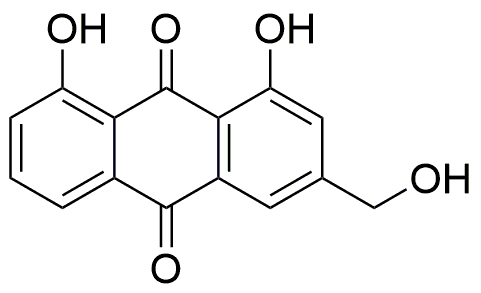Aloe emodin is widely utilized in research focused on:
- Pharmaceutical Development: Known for its potential anti-inflammatory and anti-cancer properties, it is being explored in the formulation of new drugs aimed at treating various diseases.
- Cosmetics: Commonly used in skin care products for its soothing and healing properties, it helps in promoting skin health and reducing irritation.
- Food Industry: As a natural colorant and preservative, it is incorporated into food products to enhance appearance and shelf life while providing health benefits.
- Traditional Medicine: Employed in herbal remedies, it is recognized for its laxative effects and is often used in formulations for digestive health.
- Research Studies: Frequently used in laboratory studies to investigate its effects on cell growth and apoptosis, aiding in the understanding of cancer biology.
Informations générales
Propriétés
Sécurité et réglementation
Applications
Aloe emodin is widely utilized in research focused on:
- Pharmaceutical Development: Known for its potential anti-inflammatory and anti-cancer properties, it is being explored in the formulation of new drugs aimed at treating various diseases.
- Cosmetics: Commonly used in skin care products for its soothing and healing properties, it helps in promoting skin health and reducing irritation.
- Food Industry: As a natural colorant and preservative, it is incorporated into food products to enhance appearance and shelf life while providing health benefits.
- Traditional Medicine: Employed in herbal remedies, it is recognized for its laxative effects and is often used in formulations for digestive health.
- Research Studies: Frequently used in laboratory studies to investigate its effects on cell growth and apoptosis, aiding in the understanding of cancer biology.
Documents
Fiches de données de sécurité (FDS)
La FDS fournit des informations de sécurité complètes sur la manipulation, le stockage et l’élimination du produit.
Spécifications du produit (PS)
Le PS fournit une description complète des propriétés du produit, notamment sa composition chimique, son état physique, sa pureté et les exigences de stockage. Il détaille également les plages de qualité acceptables et les applications prévues du produit.
Certificats d'analyse (COA)
Recherchez des certificats d'analyse (COA) en saisissant le numéro de lot du produit. Les numéros de lot et de lot se trouvent sur l'étiquette d'un produit, après les mots « Lot » ou « Lot de fabrication ».
Numéro de catalogue
Numéro de lot/série
Certificats d'origine (COO)
Ce certificat d'exploitation confirme le pays dans lequel le produit a été fabriqué, et détaille également les matériaux et composants utilisés et s'il est issu de sources naturelles, synthétiques ou autres sources spécifiques. Ce certificat peut être requis pour les douanes, le commerce et la conformité réglementaire.
Numéro de catalogue
Numéro de lot/série
Fiches de données de sécurité (FDS)
La FDS fournit des informations de sécurité complètes sur la manipulation, le stockage et l’élimination du produit.
DownloadSpécifications du produit (PS)
Le PS fournit une description complète des propriétés du produit, notamment sa composition chimique, son état physique, sa pureté et les exigences de stockage. Il détaille également les plages de qualité acceptables et les applications prévues du produit.
DownloadCertificats d'analyse (COA)
Recherchez des certificats d'analyse (COA) en saisissant le numéro de lot du produit. Les numéros de lot et de lot se trouvent sur l'étiquette d'un produit, après les mots « Lot » ou « Lot de fabrication ».
Numéro de catalogue
Numéro de lot/série
Certificats d'origine (COO)
Ce certificat d'exploitation confirme le pays dans lequel le produit a été fabriqué, et détaille également les matériaux et composants utilisés et s'il est issu de sources naturelles, synthétiques ou autres sources spécifiques. Ce certificat peut être requis pour les douanes, le commerce et la conformité réglementaire.


